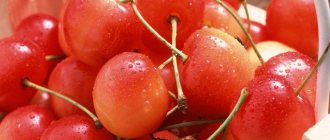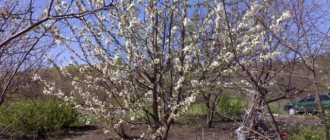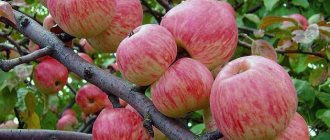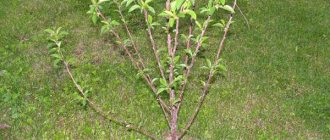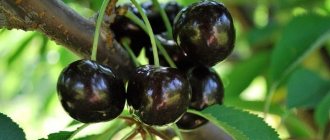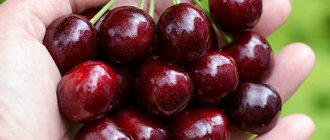Sweet cherry Tyutchevka: description of the variety
The Tyutchevka cherry was bred at the All-Russian Lupine Research Institute, a state institution where breeding work is carried out and fruit and berry crops are studied. The variety was the result of crossing seedlings Red dense and 3-36. Author – M.V. Kanshina. In 2001, the Tyutchevka variety was included in the state register. It is recommended to grow it in the Central region.
Fruits of the Tyutchevka variety weigh from 5.3 to 7.4 g, size 22x23 mm. The shape is wide and round, the color is dark red. The pulp is dense, red. The stone is oval with a pointed tip. The taste qualities of the fruit are rated 4.9 points. At high humidity, cracking of the fruit occurs.
Mature tree height
The height of the Tyutchevka cherry is about 3.5 m. The crown is sparse, semi-spreading, spherical in shape. The shoots are powerful, straight, brown in color. The buds are cone-shaped, with a pointed end.
Photo of Tyutchevka cherry:
Flowering and ripening period
Cherries form inflorescences consisting of 4 flowers. Buds appear mid-late. The harvest is formed on bouquet branches. The Tyutchevka variety ripens later: late July – early August.
Productivity
Trees enter the fruiting stage at the 5th year of life. The average yield is 97 c/ha, the maximum is 275 c/ha. An average of 16 kg of fruit is harvested from cherries, the maximum yield is 40 kg.
Transportability
Sweet cherries of the Tyutchevka variety are easily torn from the stalk without releasing juice. Due to the dense pulp, the fruits can withstand long-term transportation.
Drought resistance
Drought resistance is average. In the absence of moisture, the tree sheds its ovaries, which affects the final yield.
Frost resistance
The tree and flower buds of the Tyutchevka variety have high winter hardiness. During severe winters, the branches of the cherry tree freeze slightly.
Advantages and disadvantages of the variety
Tyutchevka is a relatively young variety, although, of course, in 17 years it has already managed to show all its positive qualities and reveal some shortcomings. Gardeners note the following as the main advantages of the variety:
- high stable yield;
- spectacular presentation and excellent taste of the fruit;
- good transportability of the crop;
- unpretentiousness to growing conditions;
- high frost resistance and disease resistance.
Relative disadvantages include fruit cracking in high humidity conditions and the need for pollinators.
How to plant Tyutchevka cherries
Proper planting of cherries is the key to their further growth and high productivity. Particular attention is paid to preparing the soil, choosing a seedling and a place for growing.
How to choose a seedling
Seedlings of the Tyutchevka variety are purchased from trusted centers or nurseries. For planting, choose high-quality plants aged 1-2 years. They are assessed visually for the absence of damage, broken shoots, mold, and signs of rot. To determine whether it is really a Tyutchevka cherry, before purchasing in the Moscow region or in another region, it is important to know what kind of leaves it has. This variety has an oval leaf blade, with a round base and a sharp tip, supported by a short petiole.
Planting dates and scheme
The timing of planting the Tyutchevka variety depends on the climate of the region where it is planned to be grown. In warm climates, the tree is planted after leaf fall, several weeks before the ground freezes. During this time, the seedling adapts to new conditions and will survive the winter without any problems. If frosts come early in the region, planting is postponed until spring. Plants are planted after the snow has melted, when the soil has warmed up and the buds have not yet swelled.
Important! If autumn frosts come earlier, the seedlings are buried in the area until spring and covered with spruce branches.
For cherries, select an area at least 5 m away from fruit and other trees. The selected location should be well illuminated by the sun, located on a hill or plain. The crop is planted in groups consisting of 2-4 different varieties. About 3 m is left between seedlings.
Pit preparation
Cherry prefers loose fertile soils: sandy loam or light loamy. In heavy clay soil, peat bogs and sandstones, the tree develops slowly and may die. Planting work begins with preparing a hole with a diameter of 60 cm and a depth of 70 cm. It is filled with a mixture of fertile soil, humus, 200 g of superphosphate and 100 g of potassium sulfate.
The pit is left for 1-2 months for shrinkage, after which planting begins. The remaining earth is poured to form a small hill. A tree is placed on top, its roots are straightened and covered with soil. The seedling is watered abundantly, and the soil is mulched with humus. For more tips on planting cherries, watch the video below.
Reviews
Anastasia, Moscow:
An incredibly durable cherry variety for our winters. I have been satisfied with my harvest for many years. Caring for the tree is the simplest, and it has its own high resistance to diseases and insects; no special treatment is necessary. Well, what can we say about the taste of the berries, they are simply magnificent.
Valentina, Ryazan:
Several years ago I planted Tyutchevka at my dacha. The tree has already grown noticeably. During all this time I did not have to fight pests or treat diseases. The tree is beautiful and grows independently. All I can do is periodically adjust the crown and wait for my first harvest, especially since these berries have simply excellent taste.
Mikhail, Rostov-on-Don:
The incredible Tyutchevka cherry tree became our celebrity on the site. We have not tried such berries yet. The incredible taste and aroma makes you pick cherries ahead of time. Our whole family grew this seedling and now we are all enjoying the fruits of our efforts.
Cherry care Tyutchevka
After planting, Tyutchevka cherries are provided with the necessary care. The tree is regularly watered and fed, the tree trunk is mulched, and the crown is trimmed.
Feeding and watering
Cherries begin to be fed 2 years after planting. In early spring, the tree trunk circle is watered with slurry with the addition of 1 tbsp. l. complex fertilizer. When the fruits of the Tyutchevka variety bloom and ripen, 20 g of superphosphate and potassium salt are added to the soil. After abundant fruiting, fertilizing with phosphorus and potassium is repeated.
Advice! It is convenient to combine fertilizing cherries with watering. The substances are dissolved in water, which is poured under the root of the tree.
On average, cherries are watered 3 times per season: during the flowering period, when the first fruits ripen and in late autumn before preparing for winter. During drought, additional moisture is allowed. Be sure to use warm, settled water.
Weeding and loosening
The soil in the tree trunk circle is loosened after watering or rains 3 to 6 times per season. As a result, the soil is saturated with oxygen, and the roots better absorb nutrients and moisture. Loosening is combined with the removal of root shoots and weeding, which take away useful elements from the soil. If the soil is mulched with humus or peat, then loosening is carried out only in spring and autumn.
Crown formation
By pruning the trunk and shoots, the yield and life of the tree increase. Treatment is carried out in spring or autumn, when the tree is dormant. The formation of a crown begins with annual seedlings that have reached a height of 60 cm. At the same time, 6 strong buds are left, from which skeletal branches will grow. In the second year, 3-4 shoots are selected to obtain the lower tier, the remaining shoots are cut off with a sharp knife. On the conductor, 3-4 buds are isolated to form the next tier, the remaining part is cut off. In an adult tree, it is enough to remove root shoots, dry broken and improperly growing shoots.
Pollinators of cherry Tyutchevka
The Tyutchevka variety has a low level of self-pollination. In the absence of pollinators, no more than 6% of fruits are set. Planting varieties that bloom at the same time as the Tyutchevka cherry helps to increase productivity.
Description of the best pollinators for Tyutchevka cherries:
- Odrinka. A mid-late variety, it bears dark red fruits with dense, sweet pulp. The variety is winter-hardy and is little susceptible to diseases.
- Revna. A variety with increased winter hardiness, partially self-fertile. The yield is plentiful, the cherries are of medium size, dense and juicy pulp.
- Annushka. Universal large-fruited variety. The tree is weak-growing, with a drooping crown. The harvest matures in the 5th year. The fruits are sweet, round and dark red in color.
Landing technology
Tyutchevka cherries are planted in mid-autumn. When planting several trees, the distance between them should be 4–5 m. 14 days before planting, it is necessary to dig holes, during which time the soil will settle, and also place the seedlings for 7 hours in a clay mixture or soak in a large container of water, this is necessary for washing out the earthen clod and straightening the roots.
Then proceed according to this scheme:
- Prepare a hole with a diameter of 60x80x80 cm.
- When preparing a hole, the soil is divided into two parts: the top layer is placed in one direction, and the bottom layer in the other.
- Then you need to make a support; to do this, drive a stake in the center of the hole.
- The top layer is combined with manure, 200 g of superphosphate, 60 g of potassium sulfur and 500 g of ash.
- The hole is filled with this mixture, leaving 40 cm to the edges; a tree is planted at this level.
- Water generously.
- Make a mound of earth around the support.
- A seedling is placed on a mound and sprinkled with the remaining soil, while the plant should be gently shaken so that the soil fills the voids.
- Pour in 10 liters of water and sprinkle with soil again, compact and water again.
Diseases and pests of Tyutchevka cherries
The Tyutchevka variety is immune to moniliosis. Resistance to coccomycosis and clasterosporiasis is average. Fungal diseases spread in cold and rainy weather. Spores enter the site along with soil, low-quality seedlings, and garden tools. The onset of damage is indicated by spots on the leaves, drying out of the shoots, and premature falling of the fruits. To protect plantings from diseases, they follow agricultural practices: cut off shoots, dig up the soil in the tree trunk circle in the fall, and burn fallen leaves.
Important! Constant care of the Tyutchevka variety reduces the risk of pest spread.
Cherries can suffer from aphids, moths, weevils, and cherry flies. Insects feed on tree sap, leaves and fruits. It is easier to identify aphids, which form colonies and live on the underside of leaves. The moth and weevil feed on young buds and ovaries, however, they can also damage fruits. Cherry fly larvae spoil the crop and leaves, forming numerous tunnels in them.
Harvesting, transportability and storage of crops
The harvest begins in early July. The shelf life of the fruit is average ; in heavy rains the berries crack. Transportability is good : the skin of the fruit, although thin, perfectly protects them from damage.
Sweet cherries are suitable for preparing various delicious desserts, and they can also be frozen.
By familiarizing yourself with the basic characteristics, rules for choosing a seedling, site characteristics, planting technology and further care for this variety, you can keep the tree healthy and delight yourself with delicious fruits. And storing cherries in the freezer will allow you to enjoy delicious compotes, baked goods and other sweets all year round.
Cherry processing Tyutchevka
When signs of disease appear, cherries of the Tyutchevka variety are sprayed with Bordeaux mixture, copper oxychloride, and solutions of HOM or Horus preparations. Insecticides Actellik, Iskra, Nitrafen are effective against insects. Preventative treatments are carried out in spring and autumn, when sap flow in trees is slow. Chemicals are used with caution when the crop is ripening. An alternative option is to prepare an infusion of onion peels or wood ash for spraying. To make the product stick to the leaves better, soap shavings are added to it.
History of origin and region of growth
Tyutchevka appeared in the State Register in the early 2000s. The basis of the new plant variety was the “3-36” cherry, crossed with the “Red Dense” variety. Work to create the species was carried out at the Bryansk Research Institute.
The result is fruit crops that are resistant to harsh winter climates. Now the tasty berry variety Tyutchevka is grown both in the southern regions of the country and in the Urals. But the new cherry variety got its name because of the chief breeder’s love for the poetry of the great poet Tyutchev.
Preparing Tyutchevka cherries for winter
Proper preparation for cold weather helps to increase the winter hardiness of the Tyutchevka variety. In late autumn, the tree is watered abundantly. Moistened soil freezes more slowly and will protect the root system. The tree trunk is hilled up, after which it is mulched with compost. Young seedlings are covered with burlap and agrofibre, which are attached to a frame. Spruce branches are placed on top, and in winter a snowdrift is thrown over it. To prevent rodents from damaging the cherries, roofing material or a special mesh is attached to the trunk.
Agricultural technology
Daibera cherry
Novice gardeners often confuse cherries and sweet cherries. Trees are identified by their bark. In the first species it is colored in gray-brown tones, and in the second it is completely brown, with reddish tints. The branches of the cherries are straight, and the seedlings themselves are tall.
To plant and grow a hybrid, you need to correctly select a viable specimen based on the following characteristics:
- its age should be at least 2-3 years, it is better to take three-year-old hybrids;
- the cutting should be 0.8-1 m in length and have up to four healthy shoots;
- purchase a specimen with a trace of grafting on the smooth bark, as this is a guarantee that it was grown in a nursery;
- the roots of the seedling must have at least 3 shoots 20-40 cm long, in this case the seedlings will take root well on the site;
- the tree should not show signs of rot or brittle branches.
If the root system is dried out and its cut is colored brown, to save the sample you need to put it in a bucket of water for 24 hours. If these measures do not help, you will need to purchase another seedling.
Cherry seedlings
An adult hybrid does not like windy or sunlit places. Therefore, for Tyutchev’s cherries, choose areas on the south or south-west side, preferably behind the wall of a building - it will protect the trees from the wind.
Note: the tree dies from excessive moisture, so it needs to be planted in places where groundwater is not suitable, for example, on a hillside.
For the seedling, loamy soil with neutral acidity is selected. It is prohibited to plant Tyutchev's cherries on clay, peat or sandy soils. This will lead to the death of the plants.
If the soil in the garden has high acidity, to neutralize it, sprinkle the soil with lime (0.5 kg per 1 sq. m). Chalk is also used for these purposes. After filling the substance, the soil is dug up. If the farmer lives in the southern part of the country, it is better to plant Tyutchev cherries in September or early October (but no later than the 15th of this month). In the middle zone, the gardener will have to carry out this work in the spring. The best time is April, before the buds swell.
The procedure is carried out as follows:
- The hole box is dug no later than a week before planting. Its depth should be 0.5-0.7 m, and its width should be up to 100 cm. The distance between adjacent holes should be at least 3-3.5 m, otherwise the trees will touch their crowns and shade each other. You need to drive a peg next to the plant. The seedling will rest on it as it grows.
- Fertilizers are added to the pit. For 1 Tyutchev cherry seedling you will need 2 tbsp. l. phosphate, 1 bucket of humus, 1 tbsp. l. potassium sulfur. To prevent the roots of the trees from getting burned, all substances are covered with a layer of earth.
- After planting, the soil around the seedlings is well compacted, watered with plenty of water, and then mulched with dry grass.
To protect the root system of Tyutchev's cherry from burns, it is straightened and then dipped in a clay mash.
Watering seedlings should be regular
Watering the seedlings should be regular, but during rains it is better to protect the plants with film.
There is no need to feed Tyutchev's cherries for the first 3 years. When the tree is 4 years old, chicken droppings or rotted manure diluted with water (1:10) are added to the soil. For 1 sq. m of crown shadow on the ground, goes up to the bucket of fertilizer. This fertilizer should be used no more than once every 3 years. For Tyutchev's cherries, urea is suitable, which is added in the amount of 30 g per 1 square meter. m shade of the tree crown. This procedure is carried out in the spring, when the weather is warm and it rains.
Note! This hybrid does not need pruning to form a crown, but sanitary maintenance is carried out regularly. To do this, remove broken and diseased branches, and cover the cuts with garden varnish.
Hybrids are protected from various diseases with special preparations that destroy fungi and microorganisms. For prevention, it is enough to carry out such work 2 times a year. To protect against pests, Tyutchev's cherries are sprayed with a solution of wood ash and soap shavings in water. If dangerous insects still appear, they are destroyed using special preparations.
For normal fertilization, pollinators are planted next to the seedlings. Suitable hybrids are Ovstuzhenka, Raditsa, Bryansk pink, Revna, Lena. If these varieties are planted on a neighboring plot, the farmer does not have to worry about pollination - it will happen automatically.
With proper care, cherries will give a good harvest
Pros and cons: is it worth planting?
Like every plant, this type of cherry has its own advantages and disadvantages, based on which gardeners decide whether to plant a tree in their gardens or not.
Advantages of Tyutchevka cherries:
- Frost resistance. Even at low Ural temperatures, the plant quickly recovers in the spring.
- Large, juicy and sweet fruits.
- With thin skin, the fruits have a long shelf life, which allows the delicacy to be delivered to remote places.
The main disadvantages of the variety are:
- Intolerance to excess moisture. Prolonged rains have a negative impact on the harvest. The fruits crack and rot, which leads to large losses of tasty and healthy delicacies.
- The variety has poor self-pollinating capabilities; an additional pollinator is required.
Important! Take this into account when planting seedlings! An excess of soil and groundwater will destroy the plant .


